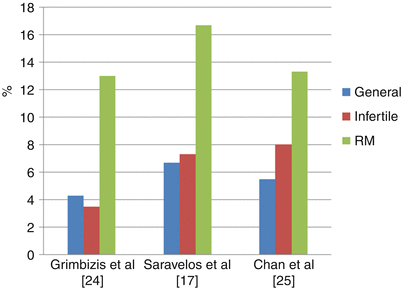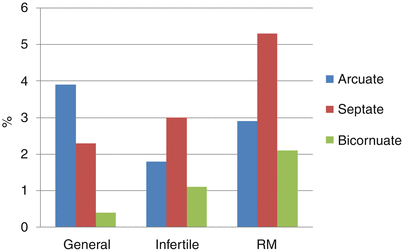Diagnostic modalities
Cases (n)
Sensitivity (%)
Specificity (%)
PPV (%)
NPV (%)
Accuracy (%)
2D US
350
56
99
96
87
84
HSG
625
78
90
83
91
86
SIU
486
93
99
97
98
97
3D US
679
100
100
100
100
100
MRI
24
100
100
100
100
100
Hysteroscopy
Laparoscopy
Used as gold standard
Evolution of Estimates
When a clear definition of population, a consistent use of classification, and application of accurate investigations are not used, the estimates of prevalence of female genital tract malformations can be misleading. For example, analysing the prevalence from over half a million unselected women using all possible modalities from 1947 to 1990 gives an overall prevalence of female genital tract malformations of 0.16 % [1], which today we know is approximately a 50-fold underestimation. Similarly when analysing the reported rates of malformations for selected populations using different investigations from the last three decades, the reported rates vary significantly from 0.4–10.8 % for the general population [18, 19], to 1–48.9 % for the infertile population [20, 21], and from 0.5 to 65.8 % for the recurrent miscarriage population [22, 23] (Table 11.2). Of course, such a wide range of prevalence is rather meaningless.
Table 11.2
The variation of reported prevalence of congenial uterine anomalies in selected populations over the last 35 years
Population | Estimated prevalence (%) |
|---|---|
General | 0.4–10.8 |
Infertile | 1.0–48.9 |
Recurrent miscarriage | 0.5–65.8 |
Recent systematic reviews have therefore tried to tackle this issue. When looking at the three largest systematic reviews of the past 15 years, it is interesting to see the evolution of estimates for the prevalence of female genital tract malformations [17, 24, 25] (Fig. 11.1). The first conclusion is that in the recurrent miscarriage population there seems to be a consistent almost threefold increase in the prevalence compared with the general population across all three systematic reviews. The second conclusion is that the prevalence in the unselected/general population and the infertile population is higher than originally estimated in the two most recent reviews, probably owing to tighter inclusion criteria for the studies analysed. Finally, the third conclusion is that, in the latest most comprehensive review and meta-analysis, the infertile population appear to have a higher rate of female genital tract malformations which was not apparent in the two previous reviews.


Fig. 11.1
The evolution of estimate of prevalence of female genital tract malformations in selected populations from three large systematic reviews
Prevalence and Different Subtypes
Using the two most recent critical reviews that controlled for the populations studied and the investigations used, the total prevalence of female genital tract malformations appears to be 5.5–6.7 % for the general population, 7.3–8.0 % for the infertile population and 13.3–16.7 % for the recurrent miscarriage population [17, 25]. This would imply a possible association with infertility and a significant association with recurrent miscarriage. However, when assessing the prevalence of different types of female genital tract malformations, according the old AFS classification, the results are more confusing. Using the data from Chan et al. [25] (Fig. 11.2) it can be seen that the arcuate uterus is more prevalent in the general/unselected population, and less prevalent in the infertile and recurrent miscarriage population. On the other hand both the septate uterus and the bicornuate uterus are more prevalent in the infertile and recurrent miscarriage population, and less prevalent in the general/unselected population. Although this may imply an association between the septate and bicornuate uterus with infertility and recurrent miscarriage, the finding of a reduced rate of arcuate uteri in these populations is counter-intuitive. Why would the arcuate uterus – embryologically a variant of the septate uterus – be commoner in the general population compared to the infertile and recurrent miscarriage population? One possible explanation is selection and operator bias: as the AFS classification does not provide objective measures to diagnose and distinguish between a normal variant uterus, an arcuate uterus and a subseptate uterus, it could be that operators were more inclined to diagnose a septate uterus rather than an arcuate uterus in women with infertility or recurrent miscarriage. On the other hand, in unselected women of no reproductive concerns, the operators may have been more inclined to diagnose an arcuate uterus (which is considered by many specialists to be a normal variant uterus) when coming across a small subseptate uterus.


Fig. 11.2
Prevalence of different types of malformations according to the AFS classification in three different population groups. Data from Chan et al. [25]
In order to reduce this bias, the prevalence of different types of malformations was reanalysed according to the ESGE/ESHRE classification. The ‘arcuate’ deformity was therefore merged with the Class U2 septate/subseptate uteri and the ‘didelphys’ deformity was merged with the Class U3 bicorporeal uteri. Following this, the commonest malformations appeared to be the Class U2 septate/subseptate uteri, followed by the class U3 bicorporeal uteri. Class U1 dysmorphic uteri, Class U4 hemiuteri and Class U5 aplastic uteri all had a prevalence of less than 1 % (Table 11.3). Interestingly, the Class U2 uteri were significantly increased in the recurrent miscarriage but not the infertile population, while the class U3, U4 appeared increased for both these population groups. The obvious limitation of this analysis is that the previous studies used to diagnose the ‘arcuate’ and ‘septate’ and ‘bicornuate’ uteri were not guided at the time by a classification that would allow for an objective measurement of parameters and diagnosis. Therefore, some arcuate uteri which will fall in the Class U2 septate/subseptate category may in fact be normal uterine variants according to the new ESGE/ESHRE classification. As a result the Class U2 uteri may be over represented.
Table 11.3




Estimates of prevalence of different genital tract malformations using the new ESGE/ESHRE classification
Stay updated, free articles. Join our Telegram channel

Full access? Get Clinical Tree


